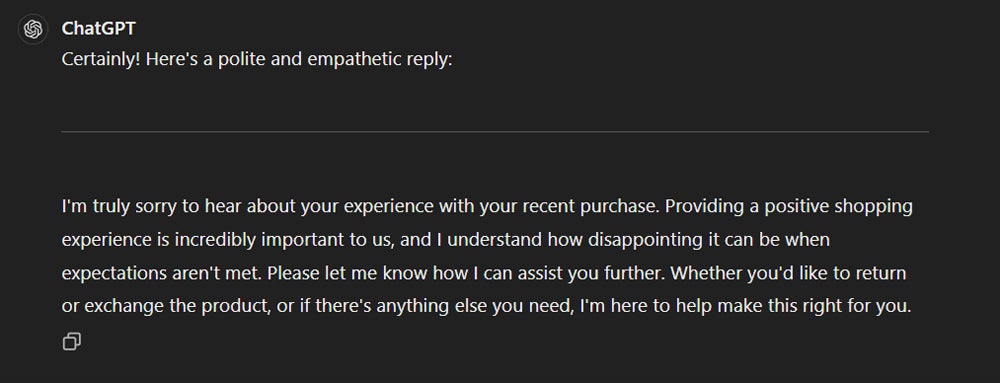Prompt engineering is the process of carefully crafting detailed inputs to get the desired outputs from an AI model. Widely used in natural language processing (NLP), prompt engineering involves tailoring the right types of prompts with the necessary level of detail to increase the system’s ability to produce meaningful outputs based on user inputs.
Understanding the different types of AI prompts and knowing advanced techniques to create them effectively and the common mistakes to avoid will elevate the quality of your prompts and maximize the potential of your AI systems.
KEY TAKEAWAYS
Prompt engineering optimizes AI model responses by guiding its outputs. (Jump to Section)
Successful AI prompts require clear goals, relevant context, and specific details. (Jump to Section)
There are several AI prompt types that serve varying purposes and applications. (Jump to Section)
Advanced prompting techniques like zero-shot, few-shot, and iterative prompting enhance AI performance. (Jump to Section)
Common AI prompting pitfalls include vague instructions, lack of context, and failure to iterate on prompts. (Jump to Section)
TABLE OF CONTENTS
What is Prompt Engineering?
Prompt engineering is a skill that requires combining technical knowledge with creative thinking to design prompts that guide artificial intelligence (AI) language models and obtain desired responses. While it sounds like a highly technical concept, prompt engineering at its core is more about language and communication.
Not every input leads to a useful output when interacting with an AI model. Prompt engineering is simply a way of helping to ensure that your query is as clear and direct as possible, directing the AI toward the correct context and intention. The process requires ongoing refinement until you get the most accurate results.
The rise of AI-powered applications and solutions has made prompt engineering an increasingly important skill.
9 Types of AI Prompts
There is a vast array of AI prompts you can apply across various domains, spanning from forming creative content to aiding in the resolution of complex problems. These prompts can elicit particular types of responses from AI systems, each built to address distinct needs and objectives. Knowing what type of prompt to use to generate the results you want is essential to working with AI models.
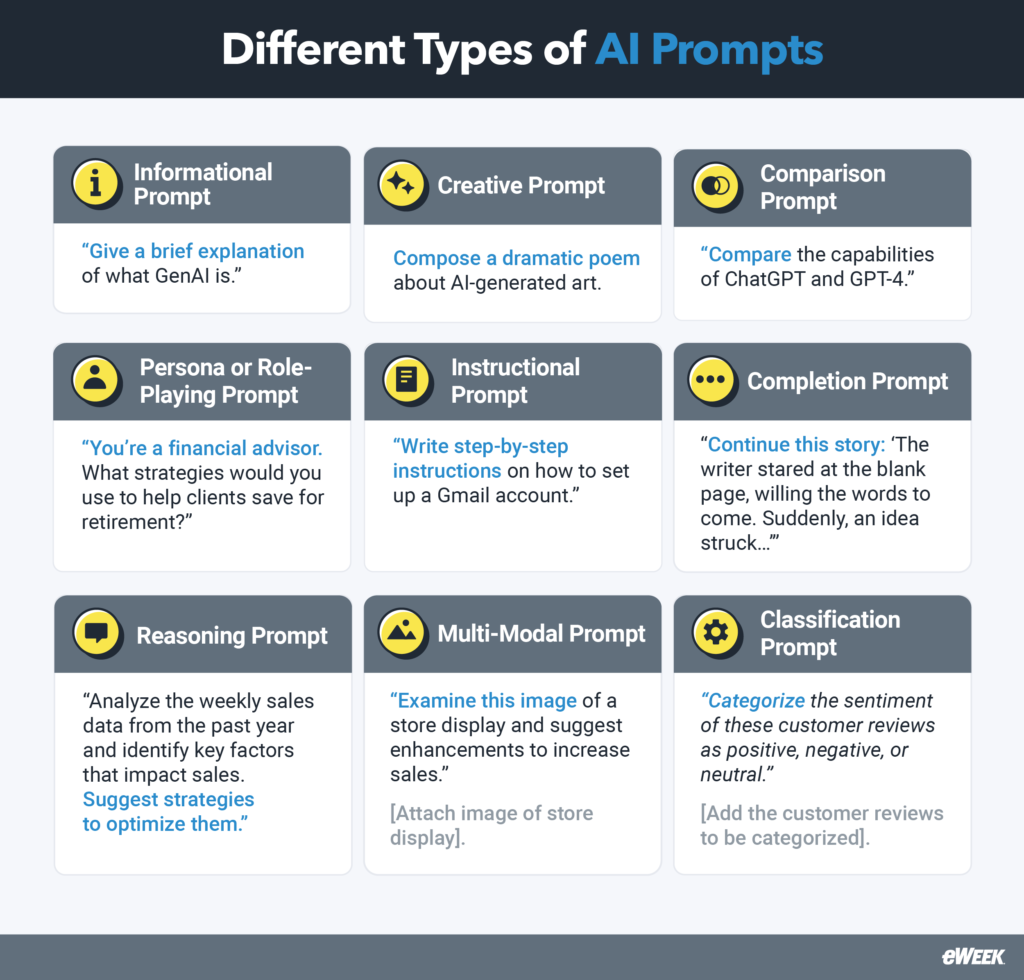
Informational Prompts
These types of requests exact information or data from the AI tool, guiding it to give factual details in its response. The expected output is a concise and informative response that directly addresses the input or query. They’re generally used for acquiring quick, straightforward information, such as definitions.
- Good Prompt Example: “Give a brief explanation of what GenAI is.”
- Bad Prompt Example: “What is the meaning of life?”
Completion Prompts
These requests equip the AI tool with a partial input and ask it to complete the rest. The AI analyzes the context and content of the given input and adds material that fits its theme, tone, and style. Completion prompts are useful for creative writing and coding.
- Good Prompt Example: “Continue this story: ‘The writer stared at the blank page, willing the words to come. Suddenly, an idea struck…’”
- Bad Prompt Example: “Once, there was a magical…”
Classification Prompts
These supply the AI with raw information and instruct it to classify that information according to predefined categories. They can be applied to different input types, including text, images, or audio, and are typically used in sentiment analysis or data classification.
- Good Prompt Example: “Categorize the sentiment of these customer reviews as positive, negative, or neutral.” [Add the customer reviews to be categorized].
- Bad Prompt Example: “Classify this text as good or bad.”
Creative Prompts
These direct the AI to create imaginative content, such as poems, songs, or even images. Creative prompts initiate the generation of original content and are open-ended, allowing for multiple possible responses from the AI. They can provide an innovative idea or theme to inspire creative output.
- Good Prompt Example: “Compose a dramatic poem about AI-generated art.”
- Bad Prompt Example: “Write a completely original, detailed, and heartbreaking short story that has never been told before, with characters and plot no one has ever thought of.”
Comparison Prompts
These instruct an AI system to compare and contrast various elements, objects, or concepts, highlighting similarities and differences. The AI model examines the common traits, features, or characteristics shared by the items or entities being compared. Comparison prompts help in understanding distinctions and evaluating diverse options to aid in decision-making.
- Good Prompt Example: “Compare the capabilities of ChatGPT and GPT-4.”
- Bad Prompt Example: “Compare the artistic styles of Leonardo DaVinci and Picasso and explain one is better than the other.”
Reasoning Prompts
These prompts command the AI system to demonstrate problem-solving skills, analyze a situation, draw logical conclusions, and explain its reasoning. Reasoning prompts involve weighing multiple factors or considering different perspectives. They’re ideal for problem-solving and decision-making.
- Good Prompt Example: “Analyze our weekly sales data from the past year and identify key factors that impact sales. Then, suggest strategies to optimize them.”
- Bad Prompt Example: “Justify why everyone should have the same political beliefs.”
Instructional Prompts
These assign a task to the AI and direct it to create step-by-step procedures to accomplish that task. These prompts go beyond simple commands–instead, they outline the specific process for the AI model to follow. They are typically used for writing tutorials or recipes.
- Good Prompt Example: “Write step-by-step instructions on how to set up a Gmail account.”
- Bad Prompt Example: “Give detailed instructions on hacking into a secure network.”
Persona or Role-Playing Prompts
These require the AI tool to simulate a particular role or persona responding as if assuming a character or viewpoint. These prompts include the goals, motivations, and expectations from the AI’s interactions while in the persona, and are widely used in interactive AI applications, like virtual assistants, to write personalized responses.
- Good Prompt Example: “You’re a financial advisor. What strategies would you use to help clients save for retirement?”
- Bad Prompt Example: “Act as a psychic and predict the future with complete accuracy.”
Multi-Modal Prompts
These engage an AI system to process and respond to different types of input, including text, images, and voice. They give the AI a richer context for constructing outputs and are used for tasks related to understanding multimedia content. Multi-modal prompts can improve the performance of AI models across a range of tasks, including image captioning and handwriting recognition.
- Good Prompt Example: “Examine this image of a store display and suggest enhancements to increase sales.” [Attach image of store display.]
- Bad Prompt Example: “Examine this person’s image and generate a detailed psychological profile based on their appearance.”
Techniques Used in Prompt Engineering
Several AI prompting techniques can help you adjust and direct AI responses to get outputs that are not only more useful, but also markedly more accurate for a variety of tasks and applications.
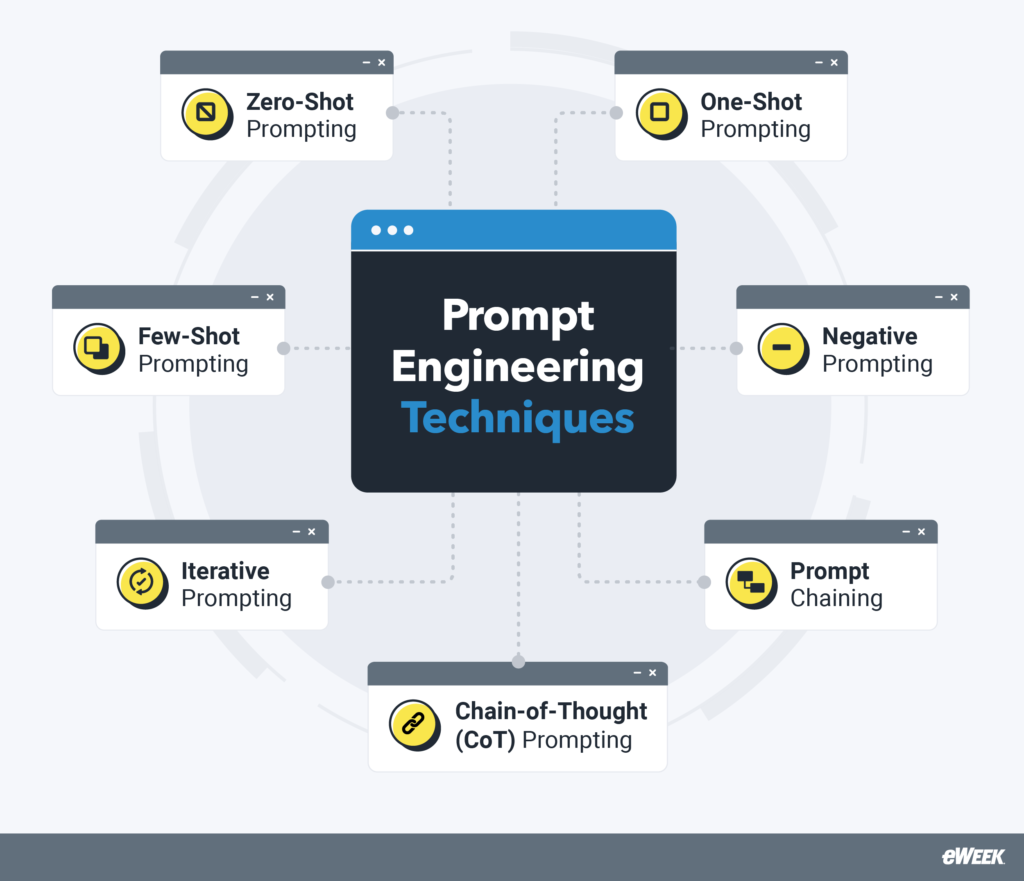
- Zero-Shot Prompting: This presents the AI model with a task it hasn’t performed before, without examples or prior context, requiring it to rely entirely on preexisting training to produce appropriate results; it tests the AI model’s capability to generalize from its training data.
- One-Shot Prompting: This provides the AI with an example of how to perform a task and guides it to respond in a similar format; using a clear reference point enables better AI responses.
- Few-Shot Prompting: This extends the one-shot approach by adding a few examples of the task; as with one-shot prompting, the examples steer the model into understanding the pattern or rules governing the task and help it to generate targeted outputs.
- Negative Prompting: This directs the AI to avoid particular elements or styles you don’t want in the output; explicitly stating negative constraints molds the AI to better tailor its response and steer clear of undesirable outcomes.
- Iterative Prompting: This method asks the AI model to refine or expand upon its initial response through multiple iterations, helping the AI progressively fine tune the quality of its first output through gradual feedback.
- Chain-of-Thought (CoT) Prompting: This approach breaks complex tasks into smaller steps that mimic human reasoning to make the AI model’s thought process more transparent and increase the accuracy of its responses by ensuring that each step of the reasoning is sound.
- Prompt-Chaining: This technique breaks down a single, multifaceted prompt into a series of interconnected, simpler prompts or sub-tasks to tackle complex tasks in a modular way; each prompt builds upon the output from the previous prompt, letting the model focus on one aspect of the problem at a time to improve precision.
7 Tips to Create an Effective Prompt
Creating an effective prompt requires creativity, analytical thinking, and a deep understanding of the AI model’s strengths and limitations. The following tips will help you write successful prompts that give clear intent and establishes context so the AI system can generate relevant information or actions:
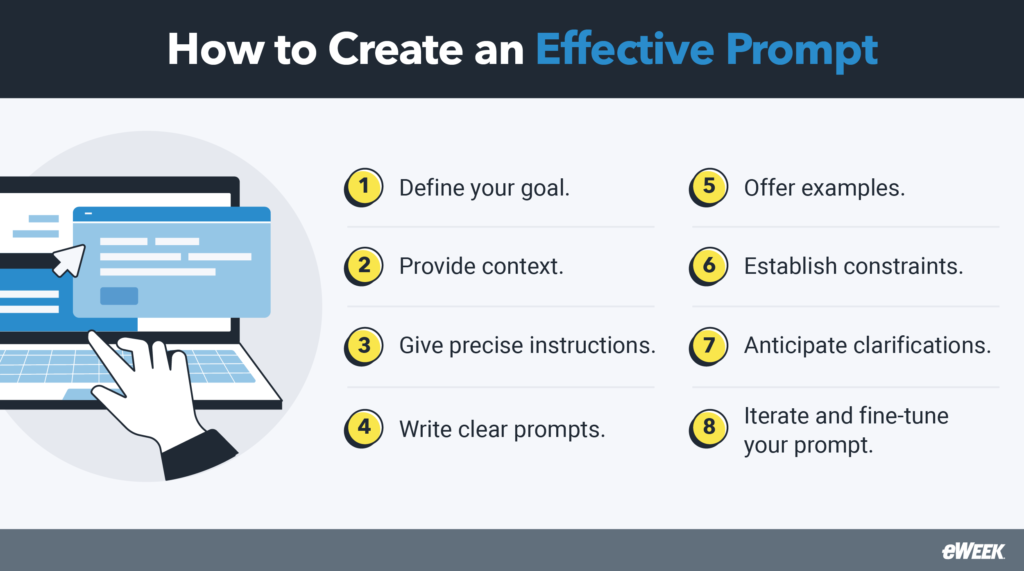
- Define Your Goals: Clearly articulate what you want the AI to do or what information you are seeking to help focus your prompt.
- Provide Contextual Information: Include any necessary background information, constraints, or specific details that the AI needs to take into account.
- Be Clear and Precise: Be straightforward and unambiguous, and avoid vague phrasing that could lead to confusion or misinterpretation—even the slightest change in word choice or phrasing could produce different results. Organize your AI prompt into a logical flow and break complex tasks down into manageable steps to avoid confusion.
- Offer Examples: List examples to the AI to clarify complex tasks—by including sample outputs alongside your main prompt, you can lead the AI model toward your targeted results.
- Establish Limits: Set any constraints or boundaries to narrow the AI’s response scope—limits help the AI understand what you do and do not want it to do, reducing the risk of irrelevant responses.
- Anticipate Clarifications: Be prepared for any potential misunderstandings or additional information you need to provide the AI for it to produce a better response.
- Iterate and Fine-Tune Your Prompts: Test your prompt and evaluate the AI’s response. If it didn’t generate your expected outcome, refine your prompt and try again. Continuous testing and fine-tuning will improve the output quality.
3 Examples of Successful Prompt Engineering
By meticulously crafting AI prompts, you can shape the AI behavior to meet specific goals and enhance performance. The following examples show how it can be used with a range of AI tools to generate better images, summarize information more effectively, and role-play as different personas.
Image Generation with Stable Diffusion
For this example, I used a creative prompt with the zero-shot prompting technique to ask Stable Diffusion AI to generate an image of a polar bear and a golden retriever in space.
Summarization with Ninja AI
For the second example, I combined an informational prompt with negative prompting to direct Ninja AI to summarize William Shakespeare’s Romeo and Juliet without using the main characters’ first names.
Persona Prompting on ChatGPT
In this case, I used a role-playing or persona prompt with the one-shot prompting technique to direct ChatGPT to act as a helpful customer service representative and write a polite and empathetic reply to a customer based on the sample response provided.
Common Prompt Engineering Mistakes
Being aware of the common mistakes in prompt engineering helps you avoid wasted time and effort and ensures the relevance and accuracy of the AI outputs.
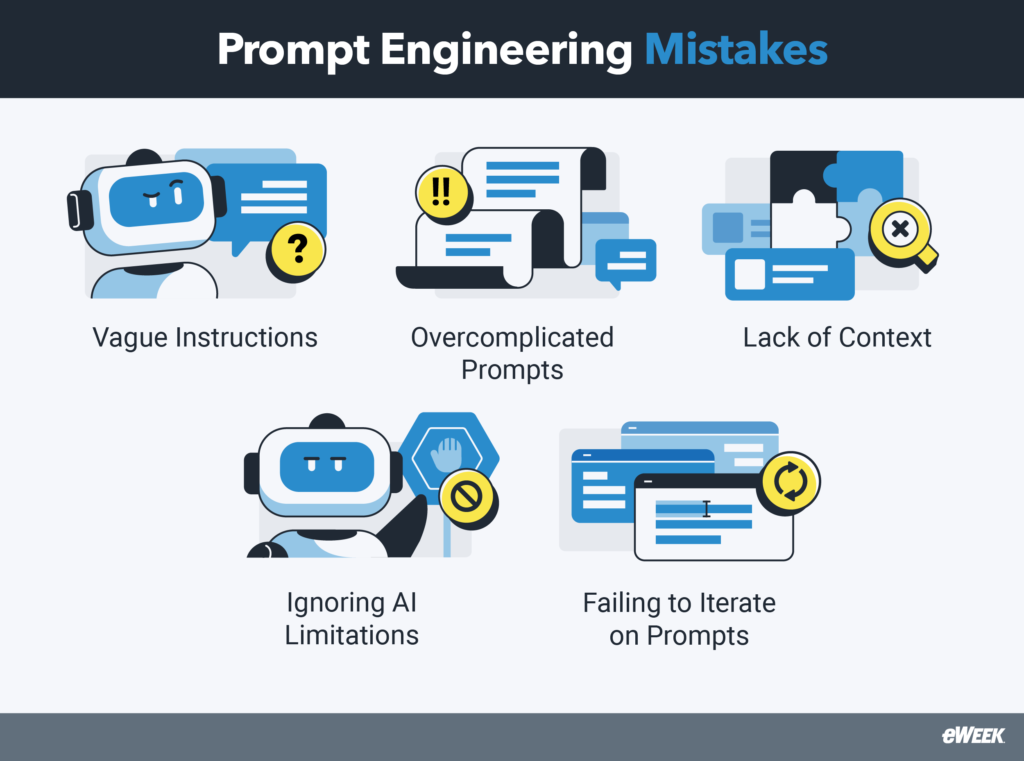
- Providing Vague Instructions: Vague instructions or broad prompts lead to unfocused outputs—be specific, because every word in your prompt matters. Indicate important details, like what you want to achieve and the output format required.
- Overcomplicating Prompts: Just as vague prompts can cause poor results, complex prompts can confuse the AI. AI systems struggle to process multiple concepts simultaneously, increasing the chances of misinterpretation and suboptimal outcomes.
- Not Giving Enough Context: Provide context, such as background information, for clarity. For example, the prompt “Explain AI in simple terms that a non-technical user can understand and use examples to describe key concepts” gives additional information to train the AI system to tailor its response.
- Ignoring AI Limitations: AI still has significant limitations to keep in mind, like lacking contextual understanding, being trained on outdated data, or responding with incorrect information (known as AI hallucinations).
- Failing to Iterate on Prompts: When you don’t iterate on your prompts, you are missing opportunities to improve the quality and relevance of the AI-generated output. Continuously adjust your prompts to get more accurate results and train the AI to better interpret your needs.
Top 3 Courses to Learn More About AI Prompt Engineering
Taking learning courses in AI prompt engineering will help you learn how to craft precise and nuanced instructions that allow the AI models to process your intent and compose useful outputs that meet your expectations. Online training provider Coursera offers a wide range of relevant courses to help enrich your skills and make you more attractive as a potential hire for the top AI companies—we recommend the following three.
Prompt Engineering Specialization, Vanderbilt University
Offered by Vanderbilt University, the Prompt Engineering Specialization is a three-part course designed to equip you with skills in crafting AI prompts for large language models (LLMs). It covers fundamental knowledge and advanced techniques, so you can use generative AI (GenAI) for automation, productivity, and intelligence augmentation.
The course is ideal for beginners and includes hands-on prompt engineering exercises. A ChatGPT+ subscription is required for completion.
Generative AI: Prompt Engineering Basics, IBM
IBM’s Generative AI: Prompt Engineering Basics course includes three modules that explore major prompt techniques like zero-shot and few-shot prompting and looks at different approaches, including Interview Pattern and Tree-of-Thought. Additionally, the course introduces AI prompt engineering tools like IBM Watson X Prompt Lab, Spellbook, and Dust.
This AI prompt engineering course is suitable for beginners and brings hands-on experience in the IBM Generative AI Classroom.
Prompt Engineering for ChatGPT
Prompt Engineering for ChatGPT is another comprehensive course from Vanderbilt University with six modules that teach effective techniques for working with ChatGPT. It covers major concepts and best practices, demonstrating how to tap into the AI’s capabilities, and offers an intuitive understanding of how language models work and how to use prompt patterns and persona prompts to achieve desired results. More importantly, it discusses prompt limitations and strategies for repeated prompt use.
Anyone can take this course—the only requirements are basic computer skills, like knowing how to use a browser and accessing ChatGPT.
Bottom Line: AI Prompt Engineering is the Key to Optimizing AI Outputs
AI prompt engineering is necessary to consistently achieve optimized NLP models. With well-structured prompts, you can train AI systems into constructing outputs that are relevant and tailored to your needs. But AI prompt engineering is not as simple as just typing a few keywords–so use this prompt engineering guide to find out the specific types of prompts for different situations. Try the various techniques we outlined to direct the AI models towards your targeted results. By combining the right prompt type with the appropriate techniques, you can get coherent and useful outputs from AI models.
Be mindful of the common pitfalls to avoid, constantly experiment and refine your prompts, and take AI prompt engineering courses. With practice and experience, you’ll develop a keen sense of how to engineer AI prompts that lead the AI systems to the targeted outputs.
Read our guide to the Best AI Productivity Tools to discover the top AI tools for streamlining workflows and boosting efficiency.


